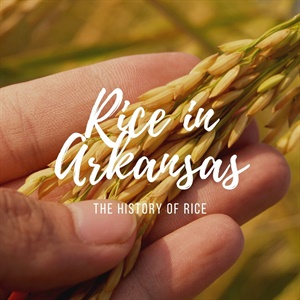By Brian Rodgers
The story of Carolina Gold rice in Arkansas may have started with a Black family who moved to the state, grew their own rice and sold rice seeds that became the foundation of the powerhouse rice industry in Arkansas today.
Carolina Gold is a specific type of rice that first appeared in South Carolina after the Revolutionary War. The story of Elias Moses and his Carolina Gold rice is one preserved through oral history and the retelling of the story from generation to generation orally.
There are few documents to tell the rich and storied history of Black communities in Arkansas, which means oral history is often the only means of preserving the past.
Elias Moses was born enslaved on a plantation in South Carolina in 1843. After the Civil War, he married a woman named Eliza, and they had five children. Sometime before 1900, he moved his family as part of an African American migration from other parts of the South to Arkansas.
Arkansas was marketed as a destination for African Americans who wanted to leave the harsh conditions of the deep South. The state was described as “a tropical country of soft and balmy air, where cocoanuts [SIC], oranges, lemons, and bananas grew. Ordinary things like corn and cotton, with little cultivation, grew an enormous yield,” according to the book “The Heir of Slaves” by William Pickens.
Of course, this description was an exaggeration, but it was successful in convincing Black people to immigrate to Arkansas. Elias and his family were a part of the large number of people who moved to Arkansas. They settled in the Richwoods Township in Lonoke County. Among the possessions that Moses brought with him on his cross-country trek were rice seeds.
In 1900, Elias Moses was a homeowner and farmer in the Lonoke County area. He used the skills he learned and perfected as an enslaved man in South Carolina growing rice to grow a small patch of rice to feed his family.
Rice is not native to the Americas and was first introduced to the colonies that would become America in the 1600s. The colonies of South Carolina and Georgia were the most successful in the early cultivation of rice. They used enslaved Africans from coastal Sierra Leone to work in the rice fields. These enslaved men and women used their ancestral knowledge to clear the land, dike the marshes and build the irrigation systems. They had the ability and know how to skim the freshwater from the tide and adjust the water to the proper level for the developmental stage of the rice. There was a high demand for the enslaved people with knowledge of rice cultivation. One group of enslaved Africans were advertised based on their ability to grow rice. The ad read, 'a choice cargo of Windward and Gold Coast Negroes, who have been accustomed to the planting of rice.'
In addition to Elias Moses, there was another man in Lonoke County who was interested in growing rice, but William H. Fuller wanted to grow rice on a large scale. Fuller did not have rice seed or know how to grow rice. The need for rice seeds created an intersection for Moses and Fuller when Fuller had the opportunity to buy rice seeds from Moses. Fuller, then, bought seeds from Moses.
Fuller was born in 1843 in Nebraska and moved to Lonoke County in a covered wagon in 1895. About a year later, while on a hunting trip to Louisiana, he noticed the terrain and soil were similar to what he knew from Lonoke County. He rightfully concluded growing rice would be profitable in the area. Once Fuller returned to Lonoke County, he decided he would experiment with growing rice on his farm. He invested $400 and began growing rice. However, he was not successful with his first foray into rice cultivation, but he resolved to continue the effort.
Fuller moved to Louisiana and studied rice cultivation with some farmers that lived in the state. After several years, he returned to Lonoke County armed with new rice growing techniques. In1903, Fuller was approached by a group of businessmen from Hazen, who offered to pay Fuller $1,000 if he could produce 35 bushels of rice per acre in 1904 or 1905. Fuller went to work and in 1904, he planted 70 acres of rice and produced 5,225 bushels of rice.
Fuller is now known as the father of the rice industry in Arkansas, but he would not have produced the rice and started a multibillion dollar industry without the Carolina Gold Rice seed that he purchased from a formerly enslaved man named Elias Moses.
Historical documentation on Moses and his rice has been lost, like many other historical documents related to African American communities nationwide. The African American community is often plagued by lost history. Therefore, there are few documents to tell the rich and storied history of a community that has deep roots in Arkansas. Documents for African American communities are often not adequately preserved, which means Black history is maintained through the oral tradition.
For more information about Black history, visit the Mosaic Templars Cultural Center from 10 a.m. to 4 p.m. Tuesday through Saturday, or call 501-683-3593.
